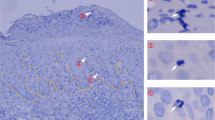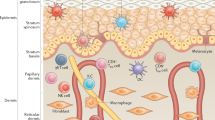Abstract
Effector memory T cells are uniquely specialized to mediate protective immunity. However, their excessive activation may result in the development of organ-specific inflammatory diseases, which have not been extensively studied. Fixed drug eruption (FDE), a localized variant of drug-induced dermatoses characterized by relapse in the same location, is a prototypic disorder mediated by excessive activation of effector memory T cells, which are resident in the lesional epidermis. A variety of clinical and pathologic features uniquely observed in FDE lesions can be explained by the presence of CD8+ intraepidermal T cells with the effector memory phenotype in the FDE lesion. This review focuses on how these T cells are generated, retained in the epidermis, and activated to cause epidermal damage.
Similar content being viewed by others
References and Recommended Reading
Mizukawa Y, Yamazaki Y, Teraki Y, et al.: Direct evidence for IFN-gamma production by effector-memory type intraepidermal T cells residing at an effector site of immunopathology in fixed drug eruption. Am J Pathol 2002, 161:1337–1347.
Shiohara T, Mizukawa Y, Teraki Y: Pathophysiology of fixed drug eruption: the role of skin-resident T cells. Curr Opin Allergy Clin Immunol 2002, 2:317–323.
Korkij W, Soltani K: Fixed drug eruption. Arch Dermatol 1984, 120:520–524.
Mizukawa Y, Shiohara T: Trauma-localized fixed drug eruption: involvement of burn scars, insect bites and venipuncture sites. Dermatology 2002, 20:159–161.
Guin JD, Haynie LS, Jackson D, Baker GF: Wandering fixed drug eruption: a mucocutaneous reaction to acetaminophen. J Am Acad Dermatol 1987, 17:399–402.
Shiohara T, Kokaji T: Polysensitivity in fixed drug eruption. J Am Acad Dermatol 1997, 37:1017–1018.
Hatzis J, Noutsis K, Hatzidakis E, et al.: Fixed drug eruption in a mother and her son. Cutis 1992, 50:50–52.
del Rio E, Guimaraens D, Aguilar A, et al.: Fixed exanthema induced by ultraviolet radiation. Dermatology 1996, 193:54–55.
Tsuruta D, Sowa J, Kobayashi H, Ishi M: Fixed food eruption caused by lactose identified after oral administration of four unrelated drugs. J Am Acad Dermatol 2005, 52:370–371.
Volz T, Berner D, Weigert C, et al.: Fixed food eruption caused by asparagus. J Allergy Clin Immunol 2005, 116:1390–1392.
Kelso JM, Keating RM: Successful desensitization for treatment of a fixed drug eruption to allopurinol. J Allergy Clin Immunol 1996, 97:1171–1172.
Shelley WB, Shelley ED: Nonpigmenting fixed drug eruption as a distinctive reaction pattern: examples caused by sensitivity to pseudoephedrine hydrochloride and tetrahydrozoline. J Am Acad Dermatol 1987, 17:403–407.
Spets AL, Strominger J, Groh-Spies V: T cell subsets in normal human epidermis. Am J Pathol 1996, 149:665–674.
Sallusto F, Lenig D, Förster R, et al.: Two subsets of memory T lymphocytes with distinct homing potentials and effector functions. Nature 1999, 401:708–712.
Masopust D, Vezys V, Marzo AL, et al.: Preferential localization of effector memory cells in nonlymphoid tissue. Science 2001, 291:2413–2417.
Verjans GM, Hintzen RQ, van Dun JM, et al.: Selective retention of herpes simplex virus-specific T cells in latently infected human trigeminal ganglia. Proc Natl Acad Sci U S A 2007, 104:3496–3501.
Komatsu T, Moriya N, Shiohara T: T cell receptor (TCR) repertoire and function of human epidermal T cells: restricted TCR V alpha-V beta genes are utilized by T cells residing in the lesional epidermis in fixed drug eruption. Clin Exp Immunol 1996, 104:343–350.
Hogan RJ, Cauley LS, Ely KH, et al.: Long-term maintenance of virus-specific effector memory CD8+ T cells in the lung airways depends on proliferation. J Immunol 2002, 169:4976–4981.
Ely KH, Roberts AD, Woodland DL: Effector memory CD8+ T cells in the lung airways retain in the potential to mediate recall responses. J Immunol 2003, 171:3338–3342.
Wiley JA, Hogan RJ, Woodland DL, Harmsen AG: Antigen-specific CD8+ T cells persist in the upper respiratory tract following influenza virus infection. J Immunol 2001, 167:3293–3299.
Theil D, Derfuss T, Paripovic I, et al.: Latent herpesvirus infection in human trigeminal ganglia causes chronic immune response. Am J Pathol 2003, 163:2179–2184.
Shiohara T, Mizukawa Y: The immunological basis of lichenoid tissue reaction. Autoimmun Rev 2005, 4:236–241.
Hogan RJ, Usherwood EJ, Zhong W, et al.: Activated antigen-specific CD8+ T cells persist in the lungs following recovery from respiratory virus infections. J Immunol 2001, 166:1813–1822.
Burrows SR, Silins SL, Khanna R, et al.: Cross-reactive memory T cells for Epstein-Barr virus augment the alloresponse to common human leukocyte antigens: degenerate recognition of major histocompatibility complex-bound peptide by T cells and its role in alloreactivity. Eur J Immunol 1997, 27:1726–1736.
Ely KH, Cookenham T, Roberts AD, Woodland DL: Memory T cell populations in the lung airways are maintained by continual recruitment. J Immunol 2006, 176:537–543.
Teraki Y, Moriya N, Shiohara T: Drug-induced expression of intercellular adhesion molecule-1 on lesional keratinocytes in fixed drug eruption. Am J Pathol 1993, 129:1015–1019.
Ghosh S, Chackerian AA, Parker CM, et al.: The LFA-1 adhesion molecule is required for protective immunity during pulmonary Mycobacterium tuberculosis infection. J Immunol 2006, 176:4914–4922.
Galkina E, Thatte J, Dabak V, et al.: Preferential migration of effector CD8+ T cells into the interstitium of the normal lung. J Clin Invest 2005, 115:3473–3483.
Mizukawa Y, Yamazaki Y, Shiohara T: In vivo dynamics of intraepidermal CD8+T cells and CD4+ T cells during the evolution of fixed drug eruption. Br J Dermatol 2008, 58:1230–1236.
Surh CD, Boyman O, Purton JE, Sprent J: Homeostasis of memory T cells. Immunol Rev 2006, 211:154–163.
Assarsson E, Kambayashi T, Sandberg JK, et al.: CD8+ T cells rapidly acquire NK1.1 and NK cell-associated molecules upon stimulation in vitro and in vivo. J Immunol 2000, 165:3673–3679.
Ge N, Nishioka Y, Nakamura Y, et al.: Synthesis and secretion of interleukin-15 by freshly isolated human bronchial epithelial cells. Int Arch Allergy Immunol 2004, 135:235–242.
Shen CH, Ge O, Talay O, et al.: Loss of IL-7R and IL-15R expression is associated with disappearance of memory T cells in respiratory tract following influenza infection. J Immunol 2008, 180:171–178.
Teraki Y, Shiohara T: IFN-gamma-producing effector CD8+ T cells and IL-10-producing regulatory CD4 T cells in fixed drug eruption. J Allergy Clin Immunol 2003, 112:609–615.
Author information
Authors and Affiliations
Corresponding author
Rights and permissions
About this article
Cite this article
Mizukawa, Y., Shiohara, T. Fixed drug eruption: A prototypic disorder mediated by effector memory T cells. Curr Allergy Asthma Rep 9, 71–77 (2009). https://doi.org/10.1007/s11882-009-0011-8
Published:
Issue Date:
DOI: https://doi.org/10.1007/s11882-009-0011-8




